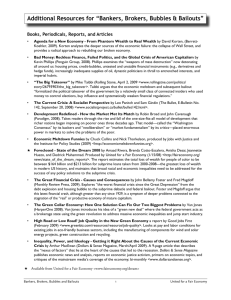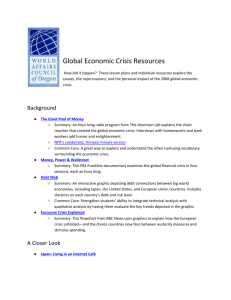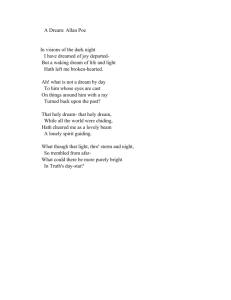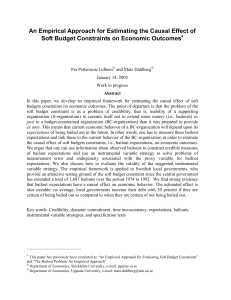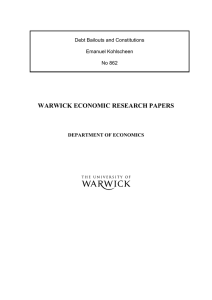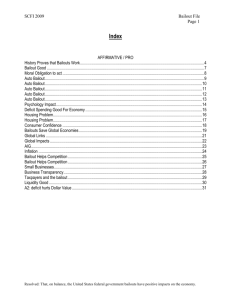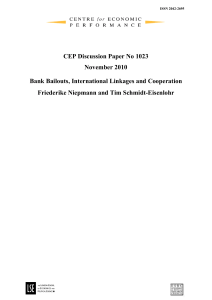Additional Resources
advertisement
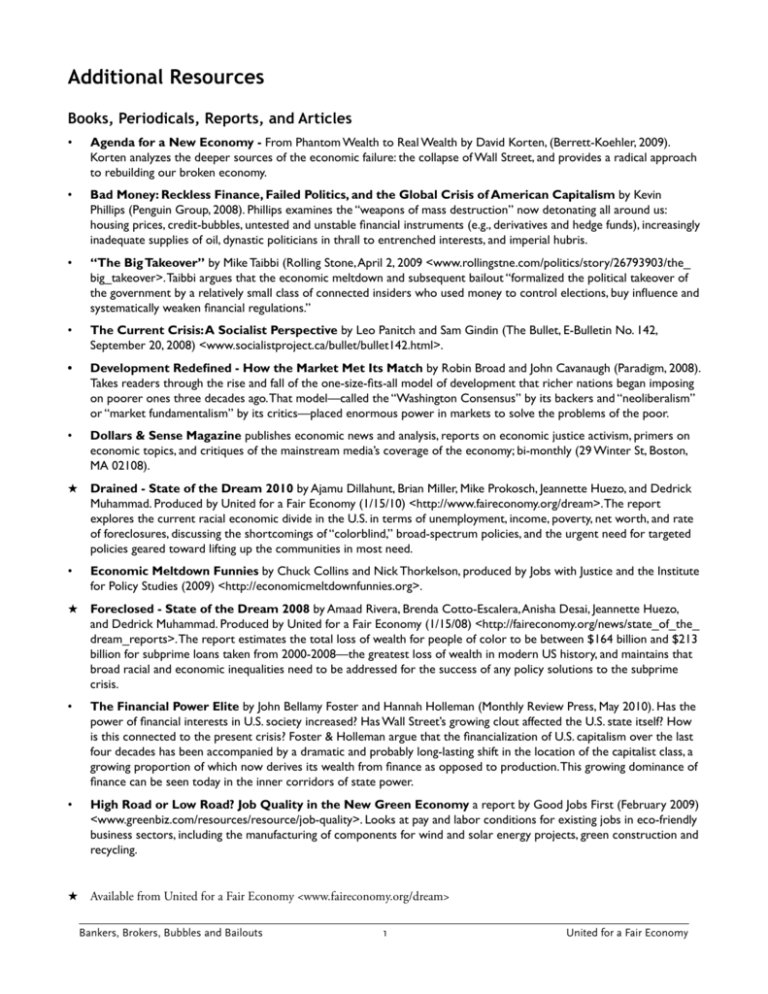
Additional Resources Books, Periodicals, Reports, and Articles • Agenda for a New Economy - From Phantom Wealth to Real Wealth by David Korten, (Berrett-Koehler, 2009). Korten analyzes the deeper sources of the economic failure: the collapse of Wall Street, and provides a radical approach to rebuilding our broken economy. • Bad Money: Reckless Finance, Failed Politics, and the Global Crisis of American Capitalism by Kevin Phillips (Penguin Group, 2008). Phillips examines the “weapons of mass destruction” now detonating all around us: housing prices, credit-bubbles, untested and unstable financial instruments (e.g., derivatives and hedge funds), increasingly inadequate supplies of oil, dynastic politicians in thrall to entrenched interests, and imperial hubris. • “The Big Takeover” by Mike Taibbi (Rolling Stone, April 2, 2009 <www.rollingstne.com/politics/story/26793903/the_ big_takeover>. Taibbi argues that the economic meltdown and subsequent bailout “formalized the political takeover of the government by a relatively small class of connected insiders who used money to control elections, buy influence and systematically weaken financial regulations.” • The Current Crisis: A Socialist Perspective by Leo Panitch and Sam Gindin (The Bullet, E-Bulletin No. 142, September 20, 2008) <www.socialistproject.ca/bullet/bullet142.html>. • Development Redefined - How the Market Met Its Match by Robin Broad and John Cavanaugh (Paradigm, 2008). Takes readers through the rise and fall of the one-size-fits-all model of development that richer nations began imposing on poorer ones three decades ago. That model—called the “Washington Consensus” by its backers and “neoliberalism” or “market fundamentalism” by its critics—placed enormous power in markets to solve the problems of the poor. • Dollars & Sense Magazine publishes economic news and analysis, reports on economic justice activism, primers on economic topics, and critiques of the mainstream media’s coverage of the economy; bi-monthly (29 Winter St, Boston, MA 02108). H Drained - State of the Dream 2010 by Ajamu Dillahunt, Brian Miller, Mike Prokosch, Jeannette Huezo, and Dedrick Muhammad. Produced by United for a Fair Economy (1/15/10) <http://www.faireconomy.org/dream>. The report explores the current racial economic divide in the U.S. in terms of unemployment, income, poverty, net worth, and rate of foreclosures, discussing the shortcomings of “colorblind,” broad-spectrum policies, and the urgent need for targeted policies geared toward lifting up the communities in most need. • Economic Meltdown Funnies by Chuck Collins and Nick Thorkelson, produced by Jobs with Justice and the Institute for Policy Studies (2009) <http://economicmeltdownfunnies.org>. H Foreclosed - State of the Dream 2008 by Amaad Rivera, Brenda Cotto-Escalera, Anisha Desai, Jeannette Huezo, and Dedrick Muhammad. Produced by United for a Fair Economy (1/15/08) <http://faireconomy.org/news/state_of_the_ dream_reports>. The report estimates the total loss of wealth for people of color to be between $164 billion and $213 billion for subprime loans taken from 2000-2008—the greatest loss of wealth in modern US history, and maintains that broad racial and economic inequalities need to be addressed for the success of any policy solutions to the subprime crisis. • The Financial Power Elite by John Bellamy Foster and Hannah Holleman (Monthly Review Press, May 2010). Has the power of financial interests in U.S. society increased? Has Wall Street’s growing clout affected the U.S. state itself? How is this connected to the present crisis? Foster & Holleman argue that the financialization of U.S. capitalism over the last four decades has been accompanied by a dramatic and probably long-lasting shift in the location of the capitalist class, a growing proportion of which now derives its wealth from finance as opposed to production. This growing dominance of finance can be seen today in the inner corridors of state power. • High Road or Low Road? Job Quality in the New Green Economy a report by Good Jobs First (February 2009) <www.greenbiz.com/resources/resource/job-quality>. Looks at pay and labor conditions for existing jobs in eco-friendly business sectors, including the manufacturing of components for wind and solar energy projects, green construction and recycling. H Available from United for a Fair Economy <www.faireconomy.org/dream> Bankers, Brokers, Bubbles and Bailouts 1 United for a Fair Economy • Inequality, Power, and Ideology - Getting it Right About the Causes of the Current Economic Crisis by Arthur MacEwan (Dollars & Sense Magazine, March/April 2009). A 9-page article that describes the “nexus of factors” that lie at the heart of the causes that led to the recession. Dollars & Sense Magazine publishes economic news and analysis, reports on economic justice activism, primers on economic topics, and critiques of the mainstream media’s coverage of the economy; bi-monthly <www.dollarsandsense.org>. • Making Change - How Social Movements Work - and How to Support Them by Manuel Pastor and Rhonda Ortiz, Program for Environmental and Regional Equity, University of Southern California (March 2009) < http://college.usc.edu/geography/ESPE/documents/making_change_executive_summary.pdf>. This 24 page paper details what makes for a successful social movement, what capacities need to be developed, and what funding opportunities might exist. • “No Return to Normal - Why the economic crisis, and its solution, are bigger than you think” by James K. Galbraith (Washington Monthly, March/April 2009). Galbraith offers a critique of the Geithner bailout as a continuation of the financialization of the economy and insufficient to reverse the squeeze on workers, the elderly, and the real economy. Galbraith suggests that we need a much larger recovery that invests in infrastructure, protects the elderly (Social Security and Medicare), and puts the unemployed to work. • Obama’s Economy - Recovery for the Few by Jack Rasmus. • Plunder and Blunder:The Rise and Fall of the Bubble Economy by Dean Baker (PoliPointPress, 2009). Through historical analysis of policy change beginning in the 1980s, economist Dean Baker describes how policy makers and the media neglected economists who foresaw the housing bubble collapse. Baker provides a specific policies to avoid such financial disasters in the future. • Principles of Macroeconomics: Activist vs. Austerity Policies by Howard Sherman and Michael Meeropol (M.E. Sharpe, 2013). An economics textbook comparing Neoclassical economic theories with Progressive economic theories, written in extremely accessible prose. It offers extensive coverage of the human toll that unemployment causes; emphasis on the basic instability of all macroeconomies and the role of business cycles; and full development of Keynesian models using the work of Wesley Mitchell. • “The Quiet Coup” by Simon Johnson, an article in The Atlantic (May 2009). The former chief economist of the IMF argues that the finance industry has effectively captured the government and that breaking that financial oligarchy is essential to preventing a depression <http://www.theatlantic.com/doc/200905/imf-advice>. • Sold Out: How Wall Street and Washington Betrayed America, a report issued by Essential Information and the Consumer Education Foundation describing how the financial sector invested more than $5 billion in political influence purchasing in Washington over the past decade, winning deregulation and other policy decisions that led directly to the current financial collapse. Available from Wall Street Watch, along with a video clip of Keith Olbermann’s show on MSNBC reporting on the report < http://www.wallstreetwatch.org/soldoutreport. htm>. • The Return of Depression Economics and the Crisis of 2008 by Paul Krugman (Norten, 2008). Nobel prize winning economist Paul Krugman describes how the lack of economic regulation set up the U.S, and the world as a whole, for the worst financial crisis since the 1930s. Krugman states the required steps to contain this crisis and put the global economy back on its feet. • The Shock Doctrine - The Rise of Disaster Capitalism by Naomi Klein (New York: Metropolitan Books, 2007). Klein exposes the thinking, the money trail, and the puppet strings behind the world-changing crises and wars of the last four decades. The Shock Doctrine is the gripping story of how America’s “free market” policies have come to dominate the world-- through the exploitation of disaster-shocked people and countries. H The Silent Depression - State of the Dream 2009 by Amaad Rivera, Jeannette Huezo, Christina Kasica and Dedrick Muhammad. Produced by United for a Fair Economy (1/15/09) <http://faireconomy.org/dream>. While the general population has been in recession for a year, people of color have been in recession for five years. The report shows the current racial economic inequity, including poverty rates, wealth and assets, and economic mobility. Racial barriers continue to impede many people of color from achieving the same economic success as their white counterparts. H Available from United for a Fair Economy <www.faireconomy.org/dream> Bankers, Brokers, Bubbles and Bailouts 2 United for a Fair Economy Video • Bill Moyers Journal - Interview with Bill Black. April 3, 2009 <http://www.pbs.org/moyers/ journal/04032009/watch.html>. The financial industry brought the economy to its knees, but how did they get away with it? With the nation wondering how to hold the bankers accountable, Bill Moyers sits down with William K. Black, the former senior regulator who cracked down on banks during the savings and loan crisis of the 1980s. Black offers his analysis of what went wrong and his critique of the bailout. • Capitalism Hits the Fan - Richard Wolff on the Economic Meltdown, 57 minutes (Media Education Foundation, 2009) <www.mediaed.org>. University of Massachusetts Economics Professor Richard Wolff breaks down the root causes of today’s economic crisis, showing how it was decades in the making and in fact reflects seismic failures within the structures of American-style capitalism itself. • The Crises of Capitalism - 10 minutes <http://www.youtube.com/watch?v=qOP2V_np2c0&feature=player_ embedded#>. An animation based on an April 2010 lecture by radical sociologist David Harvey at the Royal Society for the encouragement of Arts, Manufactures and Commerce (RSA). • Inside the Meltdown. 60 minutes (Frontline PBS, 2009) <www.pbs.org/wgbh/pages/frontline/meltdown/>. An investigation of the worst financial collapse in 70 years and how the government responded. The film chronicles the inside stories of the Bear Stearns deal, Lehman Brothers collapse, the propping up of insurance giant AIG and the $700 billion bailout. It also examines what Treasury Secretary Henry Paulson and Federal Reserve Chairman Ben Bernanke didn’t see, couldn’t stop and haven’t been able to fix. • The Global Financial Crisis - The Great Depression of the 21st Century. A lecture by Prof. Michel Chossudovsky. 78 minutes (Center for Research on Globalization, Jan. 14 2009) <www. lobalresearch. ressourcequebec.com/Lecture/January_14-2009.htm> Addresses the causes and consequences of the financial meltdown; the speculative onslaught; financial fraud and the “bank bailouts”; bankruptcy of the real economy; impacts on employment, wages and social services; the economic crisis and its relationship to the Middle East war; the centralization of corporate power; the concentration of wealth, and the globalization of poverty. • Silly Money with British satirists John Bird and John Fortune. 18 minutes (2008) <http://www.ritholtz.com/ blog/2009/01/bird-fortune-silly-money-part-1-2/>. • Too Big To Fail (2011) is based on the Andrew Ross Sorkin book of the same name. It provides a dramatized account of the closed-door wheelings and dealings of government officials and banking executives in the fall of 2008 that left Lehman Brothers bankrupt, AIG a ward of the state, and the American taxpayer footing the bill for a $700 billion bailout. Audio/Pod Casts • Giant Pool of Money - This American Life (PBS) May 9, 2008 <http://www.thisamericanlife.org/Radio_ Episode.aspx?sched=355>. A special program about the housing crisis produced in a special collaboration with NPR News. What does the housing crisis have to do with the turmoil on Wall Street? Why did banks make half-million dollar loans to people without jobs or income? And why is everyone talking so much about the 1930s? • Another Frightening Show About the Economy - This American Life (PBS) October 3, 2008 <http:// www.thisamericanlife.org/Radio_Episode.aspx?sched=1285>. The Day the Market Died: Alex Blumberg and Adam Davidson recount the 36-hour period when the credit markets froze (16 minutes). Out of the Hedges and Into the Woods: one more confusing financial product that’s bringing down the global economy: credit default swaps helped spread the sickness into an epidemic (19 minutes). Swap Cops: Ira talks with Michael Greenberger, a former commodities regulator, who tells the story of when it was decided not to regulate credit default swaps. And how that decision was emblematic of the way we didn’t regulate a lot of the toxic financial products we’re hearing about now. (8 minutes). What’s Next?: Ira and Adam answer the question: was the $700 billion bailout bill a good idea or a bad one? (10 minutes). • Bad Bank - This American Life (PBS) February 27, 2009 <http://www.thisamericanlife.org/Radio_Episode. aspx?sched=1285>. The collapse of the banking system explained, in just 59 minutes. Alex Blumberg and NPR’s Adam Davidson help all of us understand the news. For instance, when we talk about an insolvent bank, what does it actually mean, and why are we giving hundreds of billions of dollars to rich bankers who screwed up their own businesses? Also, two guys go to New Jersey to look at a toxic asset. Bankers, Brokers, Bubbles and Bailouts 3 United for a Fair Economy Bankers, Brokers, Bubbles and Bailouts 4 United for a Fair Economy
